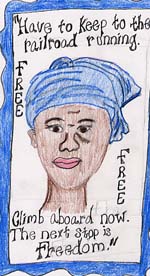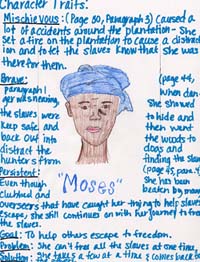
Discussion Director
Your job is to develop questions group members will discuss about this
portion of the book; decide important ideas and issues raised in this section
of the book and design questions that address them. Examples: Setting,
Problem Solving, Narrator, Topic, Main Idea, Cause-Effect, Mood, Character
Relationship, and Compare/Contrast
You will want to begin questions with words like:
Who, What, Where, When, Why, How, Tell, Describe
Character:
1. Who does everyone suspect is causing a ruckus
around the farm (starting fires, stealing eggs,
etc.)
(Page 30, Moses)
Setting - MCEOG:
2. When danger was nearing on the edge of the woods,
where did the slaves hide for protection?
A.
The woods
B.
A field of corn
C.
An old shack
D.
None of the above
(Page
44 B. A field of corn)
Setting
3. Where did Emily learn to write her name and with
who’s help?
(Page 50 Emily learned to write
her name at the Quaker’s home at which she stayed at for a week.
The nice
Quaker girl who lived there
helped Emily learn how to write her letters and spell her name.)
Cause/Effect
4. What did Clara do with the salt and sugar
and what happened to her as a result?
(Page 32-33 Clara mixed
up the salt and sugar and instead of the Mas’r getting sugar in his coffee
he got
salt. As a result
of this, Clara was sent out to work in the fields for a week.)
Problem/Solution
5. How did Clara escape punishment for not having
collected enough cotton?
(Page 35 All of the slaves knew that Clara would not be able to collect
enough cotton, so at the end of the day they added some of the cotton they
had collected to her bag and when that was not enough Isaiah put rocks
in her sack to give it more weight.)
Passage Picker
Your job is to select significant passages from the sections being
read; determine why it is important; call other readers’ attention to the
passage and lead discussion on it.
Steps:
1.
Pick out a passage that you would like to share.
2.
Write down the page and paragraph number.
3. Write
down the first two words and the last two words of your passage.
4. Write
down the reason you chose the passage, and explain why!
5. Ask
a question about your passage, and give and answer.
6. Write
down the Author’s Purpose: To Describe, To Entertain, To Inform,
or To Persuade.
1. Passage One - Descriptive
2. Page 38, Paragraph 6
3. “Quick as…and outside.”
4. I chose this passage because it contained an example
of a simile.
5. Q: What was Emily compared to in the simile?
A: Emily quickness is compared
to the quickness of a dragonfly on water.
6. Author’s Purpose: To Describe
1. Passage Two - Descriptive
2. Page 39, Paragraph 5
3. “It was…follow it.”
4. I chose this passage because it was very descriptive.
From the details I could draw a picture in my mind of what it would
have been like in the woods that
night.
5. Q: What did an owl’s hoot mean to the slaves?
A: The slaves would say
that when you heard an owl hoot, someone was dying.
6. Author’s Purpose: To Describe
1. Passage Three - Descriptive
2. Page 41, Paragraph 1
3. “Emily did…over the rocks.”
4. I chose this paragraph because it contained a
simile - “She moved like a deer.”
5. Q: Why did the Author compare Moses to a
deer?
A: Because she didn’t make
any more noise than the water running over the rocks.
6. Author’s Purpose - To Describe
1. Passage Four - Historical
2. Page 47, Paragraph 6
3. “The man…pass to you.”
4. I chose this passage because it described
something that took place during this time period. When out traveling
on the
road the slaves had to carry
passes with them. The passes included: whom they belonged to
and where they were
supposed to be going.
5. Q: Who stopped the man and asked for his
pass?
A: Moses - Harriet Tubman
6. Author’s Purpose - To Describe and Inform
Character Sketcher
Moses - Harriet Tubman
Character Traits:
Mischievous: (Page 30, Paragraph
3) Caused a lot of accidents around the plantation - She set a fire on
the plantation to
cause a distraction and to let
the slaves know that she was there for them.
Brave: (Page 44, Paragraph
1) When danger was nearing, Moses showed the slaves were to hide and keep
safe and
then went back out into the woods
to distract the dogs and hunters from finding the slaves.
Persistent: (Page 45, Paragraph
4) Even though she has been clubbed and beaten by many overseers that have
caught
her trying to help slaves escape,
she still continues on with her journey to free the slaves.
Goal: To help others escape to freedom.
Problem: She can’t free all of the slaves at one time.
Solution: She takes a few slaves at a time
and comes back for the others at a later date.

Word Wizard
1. Flickered (Page 28, Paragraph)
2. “They flickered up over the roof of the stables.”
3. Flickered – To burn or shine fitfully or with
a fluctuating light.
4. Flickered – A flutter of light.
5. Verb
6. The light in the attic flickered on and off, scaring
the children.
1. Scythes (Page 45, Paragraph)
2. “When they came back, they were carrying hoes
and scythes.”
3. Scythes – An implement used for mowing (grass)
and composed of a long curving blade fastened at an angle to a long
handle.
4. Scythes – A long blade used to cut tall grass.
5. Noun
6. We had to use scythes to cut the grass because
it was too tall to cut with the lawn mowers.
7. Word Wizard
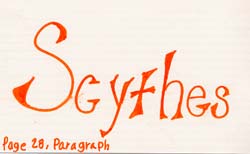
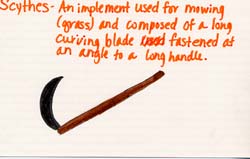
1. Hoecakes (Page 34, Paragraph 3)
2. “Emily shared the hoecakes that the slaves made
from flour and water.”
3. Hoecakes – A small cake made of cornmeal.
4. Hoecakes –
5. Noun
6. Grandma made the hoecakes from flour and water.
1. Wreckage (Page 30, Paragraph 5)
2. “Her eyes were white, staring at the wreckage.”
3. Wreckage – Broken and disordered parts.
4. Wreckage – Materials from something wrecked.
5. Noun
6. The wreckage from the ship was found at the bottom
of the ocean.
7. Word Wizard Card
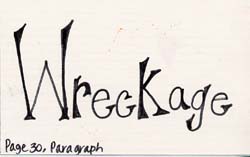
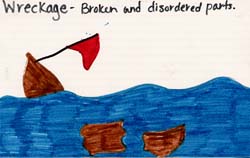
Visual Arts Repsonse - Commemorative Stamp
Select a key character or scene, or focus on an important theme from
you book and develop a stamp to commemorate that character, scene, or theme.
Include a picture, a selected phrase, and the stamp's value to highlight
your choice.
